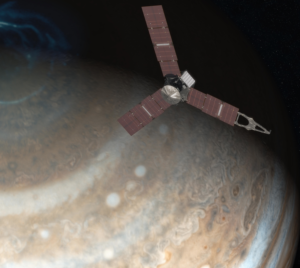Recently, NASA’s JUNO spacecraft slowed down by 1,212 miles per hour in a carefully coordinated 35 minute maneuver. This slowdown is similar to you slamming on the brakes to stop your car on the highway in 2 seconds. Braking to the exact right speed allowed JUNO to be captured by Jupiter’s gravity and start orbiting the giant planet. Just like a long road trip, as spacecraft travel from Earth to their destination, they often cruise at high speed to reach their destination in a relatively short amount of time. But that means if you want to orbit or land on the planet, you must slow down a lot. Here are three ways NASA has dealt with the tricky task of ending a planetary road trip.

Slow Down
Slowing a spacecraft down requires some finesse. This is typically done by firing some small rockets on the spacecraft, a maneuver called an orbit insertion burn. Engineers slow the spacecraft down to just the right speed and then let gravity do its thing. You do have to ensure, of course, that the engines fire in the correct direction for the correct amount of time. Slow down too much or for too long and you might plummet straight into the planet. Slow down too little and you might fly right by.
Just like Juno, many spacecraft have hit the brakes to orbit a planet. The Cassini Mission arrived at Saturn in 2004 after a 7 year journey. It had to slow down by nearly 1,400 miles per hour in order to be captured by Saturn’s gravity. Cassini went on to provide a wealth of information about Saturn and its moons. Similarly, the Lunar Reconnaissance Orbiter took the same approach to slow down and start orbiting the Moon in 2009.
The benefit of slowing down is that you get to stay at your destination. Cassini has orbited and collected data about Saturn since 2004. The Lunar Reconnaissance Orbiter is still at the Moon. Juno will operate at Jupiter for about 18 months before its mission ends and it is sent to a fiery death in Jupiter’s atmosphere.
Keep on Going
Instead of stopping at a destination, another option is to just keep going. You do not have to worry about the complexity of slowing down the exact amount, but you also don’t get to stay at one place for a long time. However, you might be able to go visit other planets, asteroids, or comets after your initial goal.
New Horizons took this approach last summer when it visited Pluto. New Horizons collected data for 6 months as it flew within about 8,000 miles of Pluto. The advantage of this option is you might be able to go visit something else. New Horizons will perform a similar flyby of a small Kuiper Belt Object named 2014 MU69 in 2019 to study one of the furthest objects in the solar system.
Parachutes, Sky Cranes, and Airbags
The task gets more difficult if you want to land on the planet. You don’t just have to slow down, you have to stop. And you must stop in the right place. Landing on a planet can be a fairly violent experience, so you must take care to ensure all the delicate scientific instruments are safe.
Both the Mars Pathfinder mission in 1997 and the Spirit and Opportunity rovers in 2004 used a combination of parachutes, rockets, and airbags to land on the Red Planet. They first used a parachute to initially slow down, then rockets to slow down more. Since that did not slow them down enough, they inflated multiple airbags to bounce down onto Mars.
Finally, the most extravagant method award belongs to the Mars Curiosity rover. In what was described as seven minutes of terror, Curiosity fired engines, parachuted, hovered above the ground, and was gently lowered onto the surface by a sky crane. Check out this video of all the things that had to go correctly (and did!) for Curiosity to safely land on the surface:
There are a few option to end a planetary road trip when a spacecraft reaches its destination. The choice that scientists and engineers must make depends on the scientific and practical goals of each individual space mission.